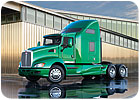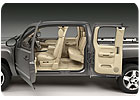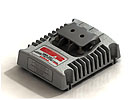
Advanced Assembly, Kenworth and Vanner all have something in common: They manufacture trucks or components used by truck manufacturers. In addition, all three facilities were finalists in the 2008 Assembly Plant of the Year competition sponsored by ASSEMBLY magazine.
There was a strong field of candidates for the fifth annual award. That made it difficult for the team of judges, which included ASSEMBLY’s editorial staff, to narrow down the list to four finalists.
All of the assembly plants were worthy of consideration, but at the end of the evaluation process one stood out from the others: the IBM High-End Server Plant in Poughkeepsie, NY. The facility was selected as Assembly Plant of the Year because of the way it has combined lean and green manufacturing initiatives to stay innovative in today’s global economy.
However, the other finalists are also quite impressive, because they all specialize in flexible, high-mix assembly. Here’s a brief look at what makes each of these world-class plants stand out.

Advanced Assembly LLC
The interior is the only part of a vehicle that drivers have an intimate day-to-day connection with. As people spend more time driving, seats are growing increasingly important to consumers. They’re demanding seats that provide comfort, convenience, safety and security.
Advanced Assembly LLC (Columbia City, IN) builds seats for AM General LLC (South Bend, IN) and General Motors Corp. (GM, Detroit) truck plants in Mishawaka, IN, and Roanoke, IN, that assemble vehicles such as the Chevrolet Silverado, GMC Sierra and Hummer H2.
The company recently took several steps to improve productivity and shorten time to market by investing in new assembly tools and state-of-the-art technology. For instance, Advanced Assembly has installed five vision-guided robots over the last two years that have saved the company more than $690,000. It also uses automated guided vehicles to deliver parts to the assembly line, in addition to DC electric fastening tools and a modular twin-track conveyor system equipped with radio frequency identification (RFID) pallet tracking.
Those investments have helped the plant increase operating efficiency while reducing labor and overhead costs. Last year, Advanced Assembly exceeded its goal for margin improvement by 185 percent, and the company is on track to exceed that goal by more than 150 percent in 2008.
Other tools the plant uses to improve productivity include:
- Proximity sensors that electronically verify the bolt or nut that’s being torqued.
- Laser and vision systems that electronically verify seat-specific content.
- A wireless scanning system that captures incoming raw material for comparison with electronic shipping documents.
“We also interrogate multiple trigger points in our customer’s preassembly process,” says David Berkes, quality manager. “These triggers drive our build file, allowing us to assemble products on a just-in-time basis and sequence delivery of seats within three hours of point of use.
“Our delivery trailers are fully automated and equipped with an internal conveyor system that allows for quick, error-free delivery,” adds Berkes. “In addition, each delivery trailer employs a GPS tracking systems that allows us to receive immediate information on truck location and time of arrival at our customer. Our automated storage and retrieval system is dynamic; it adjusts to our customer mix swings, allowing for efficient storage of approximately six hours of finished product.”
Operators have played a key role in the success of the TS 16949 and ISO 14001-certified plant. For instance, they participate in continuous improvement workshops and self-directed work teams that address issues relating to productivity, quality and safety on the plant floor. “Our associates play an active role in the successful implementation of new assembly strategies,” says Berkes.

Kenworth Chillicothe
Next time you drive on a highway and pass by a big truck, briefly look in your rearview mirror. Chances are you’ll see a big red and white KW logo on the front grill. Because of its product innovation and reliability, Kenworth Truck Co. (Kirkland, WA) is recognized as the industry leader for Class 8 trucks. The company builds two of its most popular vehicles, the T660 and the T2000, at a 35-year-old plant in Chillicothe, OH.Although the heavy-duty truck market declined substantially in 2007 compared to the previous year, major capital investments were made in the plant to achieve lean processes and significantly increase capacity. The expanded use of robotics, logistics and RFID technology has streamlined operations and improved productivity and efficiency by 20 percent.
For example, a new automated robotic fuel tank welding cell uses state-of-the-art technology. “The benefits are improved quality, reduced damage, reduced cycle times and lower manufacturing costs,” says Joe Zitzelberger, director of manufacturing development.
Personal computers, scanning devices and handheld computers are connected wirelessly plantwide, supporting mobile applications and flexible work area configuration. Operators also use DC electric fastening tools to tighten joints in critical areas, such as axle and frame assembly. Recently, 10-spindle DC nutrunners were added to install tires on the main assembly line. They replaced five-spindle tools and changed the lug-nut tightening process from two stages to a one-stage operation.
Earlier this year, the ISO 14001 plant set a new record by achieving the best monthly quality score in the facility’s history. Zitzelberger attributes some of that success to a 105,000-square-foot plant expansion project that was finished last year. Every production process in the plant was rearranged.
That allowed new layout and relocation of key assembly processes, such as sleeper build, cab build, sleeper trim and cab trim. “The new layout of the sleeper build area is in a star-shaped cell formation that allows unique fixtures to feed into a common assembly line in a much reduced assembly footprint,” says Zitzelberger. “The cab build area process changes included modular assemblies and parts kitting, and an increased number of universal fixtures that feed to a common powered conveyor system.”
What previously was an oval-shaped cab trim line for all model content variations was reconfigured to two new straight-line cab trim areas that optimize assembly processes based on customer-content requirements. This straight-line flow to and through the production line was also used to configure the new sleeper trim line.

Vanner Inc.
During the past five years, Vanner has boosted productivity by 30 percent. “Using lean techniques, we have reduced our lead time from six weeks to two weeks,” says Brenda Porter, vice president of operations. “In critical instances, we have built and shipped products the same day. Our cycle time has been reduced from four to six weeks to [less than two] hours.”
Vanner uses a scalable manufacturing structure that allows it to break down production processes into smaller steps. That helps increase throughput and reduce lead time. The company has also invested in new technology to improve productivity. For instance, Vanner recently implemented a high-speed surface-mount assembly line.
“Previously, our placement rates for electronic parts were at a maximum of 750 parts per hour using an automated through-hole assembly machine,” says Porter. “Our surface-mount line achieves component placements in excess of 3,500 parts per hour. In addition, we have streamlined our circuit board assembly process so that we can deliver completed circuit boards to our engineering group three days from the time that they deliver a completed design to us.”
In addition, Vanner has remodeled its existing final assembly line to allow operators to build products on conveyors. “This reduces the time and effort required to move units on and off the line for assembly on benchtops,” says Porter. “We also consolidated tools and parts so that multiple units can be built at the same workstation with little or no changeover.”
A team-based employee involvement structure has resulted in 100 percent on-time demand fulfillment of customer orders. Vanner uses a circular organizational chart. “Responsibility and decision-making is placed where the action is,” explains Porter. Because each team focuses on continuous improvement, the company has eliminated non-value-added activity. For instance, Vanner no longer has a master scheduler.
“Each day, the teams on the production floor regenerate the operating system, print their production schedules, look for customer orders, create work orders, and produce products to fill the new orders,” Porter points out. “We only build what we can finish daily, and build one piece at a time.”
Nomination forms for the 2009 Assembly Plant of the Year award will be available early next year at www.assemblymag.com
